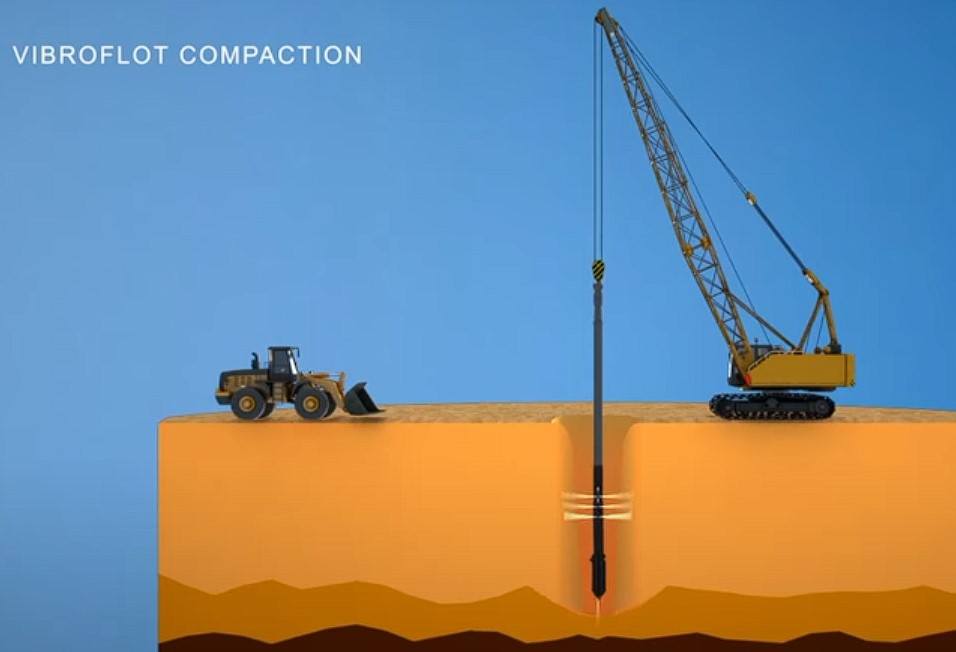Table of Contents
What is vibro compaction?
A downhole vibrator is used in the ground improvement technique known as “vibro compaction” to densify clear, cohesionless granular soils. This technique has been applied, which Keller first devised in the 1930s, to thousands of projects since then.
Common uses:
- Reduce the settlement of the foundation
- Increasing bearing capacity will allow for a reduction of footing size.
- Increased stiffness
- Strengthening shear force
- Reduced permeability
- Reduce the likelihood of liquefaction
- Provide slope stabilization
- Permit infill construction
- Permits the construction of shallow footings
- Prevent lateral spreading brought on by earthquakes
- Incredibly efficient for sand compaction and land reclamation

Method Statement for Vibro Compaction Works
The purpose of this method statement is to outline the process and guidelines for executing vibro compaction works. Vibro compaction is a ground improvement technique used to increase the density and strength of loose granular soils.
Both the improvement of loose, naturally occurring fine sands and the compaction of Fills can be accomplished with the use of vibro compaction technology. Depending on the size of the equipment utilized, this technique can enhance relative density, lower the risk of liquefaction from a seismic event, and improve depth up to 20.0 m or even much deeper.
If the silt concentration is higher than 20%, it is impossible to use the vibro-compaction technique successfully.
A certified surveyor must lay out the placement of the compaction points using approved probe layout drawings. In order to keep the points visible to the operator and foreman, the points must be marked by driving steel pegs into the ground. The pegs will also be marked with working tape.
Heavy-duty vibrating pokers will be used to carry out the densification of essentially granular soils. The eccentric weight in the bottom section of the cylindrical vibrating poker is rotated by a hydraulic motor.
A vibration isolator, the objective of which is to limit vibration to the bottom section only, separates the lower working section of the vibrator from the upper “non-working” section of the poker. The lower portion of the poker vibrates when the eccentric weight is rotated in a horizontal plane.
A tracked crawler crane is used to suspend the vibroflot. By combining the vibratory action of the poker (vibroflot) and the jetting action of high-pressure water from nose cone jets, penetration at each compaction point to the desired depth is achieved.
The soils around the vibrator are momentarily liquefied by high-pressure water jetting, which also helps with penetration. The water pressure on the nose cone compact is reduced when the desired depth is reached, and occasionally additional lower-pressure side water jets are used to assist in the compacting phase.
In order to allow the vibroflot or poker’s vibratory action to compact the soils around the point of insertion, the vibroflot is removed in stages with proper pauses at regular intervals. The objective of the additional side jets (if used/required) is to promote erosion of the granular soils along the bore and assist in their introduction to the compaction zone.
To provide a compact zone of the ground around the point of insertion, the vibroflot is progressively brought to the surface in this manner. The pace of extraction would be adjusted to meet the actual conditions encountered to provide the proper level of densification. Additional sand could also be injected from the surface.
The method is often only applied to fine-grained, pure soils that include less than 15% particles (silt/clay). There will be a decrease in volume as a result of the vibro compaction, which is rearranging the sand particles into a denser form. This loss in volume will be visible at the surface as a cone of depression.
Normally, sand would be added to this and compacted to the surface using a vibroflot in stages. Sand provided by the client will be utilized to compact the surface to the necessary level following the measurement of the vibro-compaction post-treatment levels. The installation process is illustrated in the appendix.
After the treatment is finished, foundations can be built to normal depths (above 0.50 m), and floor slabs can be built normally (depending on the loads) after the surface has been proof-rolled.
The contract calls for pumping water from a nearby body of water.
Spacings and Depth for Treatment
It is standard practice to estimate the necessary bearing pressure and use that information to determine the proper compaction spacing. This can be viewed in terms of a foundation-level particular treatment or regional treatment. The following treatment plan is recommended based on the trials carried out at this site. In the space allocated to us, the vibro compaction will be carried out in a triangular pattern.
In order to evaluate the effectiveness of the treated ground, a post-vibro compaction static cone penetration test will be carried out in order six to ten days after the conclusion of the vibro compaction operations.
Site Records
There will be prepared drawings showing the positions of all compaction points in relation to established reference points and/or guidelines. A distinct number will be assigned to each compaction point.
The following information for each compaction point (probe) shall be included on daily record sheets that are prepared.
- Probe No.
- Installation Date
- Penetration depth
- Start Time
- Completed time
- The range of hydraulic pressure during penetration
- During extraction and compaction, hydraulic pressure
- During penetration, the water pressure of the tip nose jets
- Side jets’ water pressure
- Quantity of the sand fill
- Prior to treatment, the original ground level level
- After treatment, the level of the ground
tag: # Method Statement for Vibro Compaction Works

